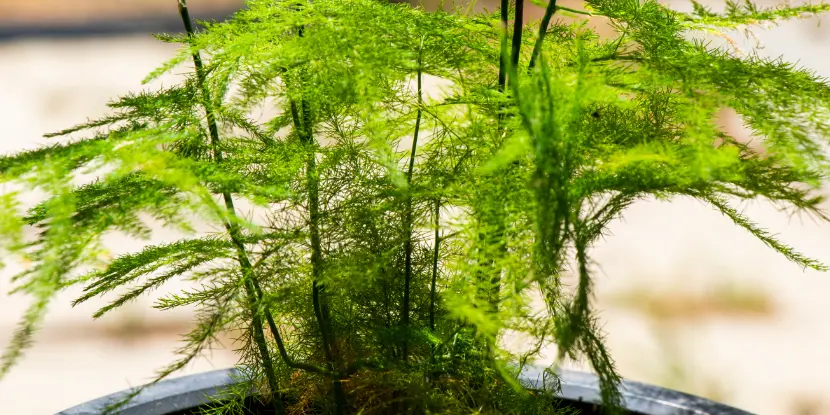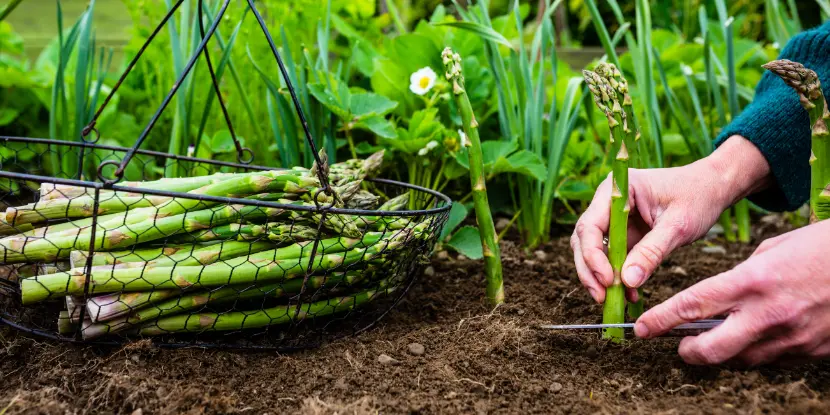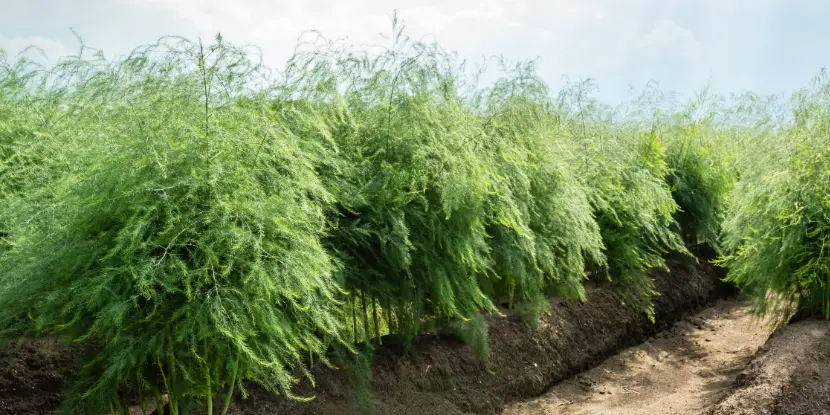Asparagus originated in Mesopotamia and the East Mediterranean area. Cultivation traces back thousands of years and found its way to California in the late 19th century. The first commercial California crop was grown on Bouldin Island in 1892.
The plant does well in Southern California’s climate — a boon to local gardeners who relish its succulent, flavorful spears.
Asparagus officinalis also lends beauty to a garden with its elegant, feathery foliage. Once established, it requires little maintenance.
Fun Facts about Asparagus Plants
- Asparagus plants are perennial vegetables, producing tasty spears year after year.
- Some varieties of asparagus live up to 20 years or more when properly cared for.
- Growing asparagus demands patience. It typically takes two to three years from planting to produce edible spears.
- Asparagus has a rich history, with evidence of its cultivation dating back thousands of years, even appearing in ancient Egyptian tombs.
- Asparagus plants exhibit gender roles, with male plants producing higher yields of larger spears than female plants.
Ideal Growing Conditions
Best Temperatures for Asparagus
Asparagus plants thrive in temperate climates with cool winters and moderate summers. They go dormant during the winter months, when temperatures are optimally between 30°F to 50°F (-1°C to 10°C).
In spring, asparagus spears emerge when soil temperatures reach approximately 50°F (10°C).

A woman picking fresh asparagus from her garden.
Soil pH Levels
Asparagus prefers a slightly alkaline to neutral soil pH, ranging between 6.5 and 7.5.
Before planting, test the soil pH and amend it with lime if it’s too acidic or sulfur if it’s too alkaline.
Well-drained, deep, sandy loam supports the extensive root system while providing good drainage.
Sunlight Requirements
A minimum of 6 to 8 hours of direct sunlight daily promotes vigorous growth and spear production.
Inadequate sunlight may lead to weak, spindly plants and reduced yields. Place your asparagus in a spot that receives ample sunlight throughout the day.
Water Requirements
Maintaining consistent moisture levels is crucial, especially during the spear production period in spring and the subsequent fern development phase.
Asparagus plants need about 1 to 2 inches of water per week from rainfall or supplemental watering.
During dry spells or in areas with less frequent rainfall, water the plants regularly to prevent the soil from drying out, which can hinder growth and reduce yield.
Mulching helps retain soil moisture, suppress weed growth, and maintain a consistent soil temperature.
Drip Irrigation
A drip irrigation system offers many advantages.
- It delivers water directly to the root zone of each plant, minimizing water waste and ensuring efficient water is use.
- It limits the water available to weeds.
- It keeps foliage and asparagus spears dry, discouraging foliar diseases, a problem with standing water on the leaves.
- It can be automated, a convenience for busy gardeners.
- It promotes deep, robust root systems, enhancing a plant’s drought tolerance and overall health.
Planting Asparagus
In California, the ideal time to plant asparagus crowns is in the early spring, from late February through April. Gardeners should have crowns in the ground as soon as the soil can be worked and the danger of frost has passed.
The planting area should be at least 4 feet wide and as long as needed for the number of cultivated plants. Plants spaced 18 inches apart will develop larger spears than those placed 15 inches apart.
The planting row should be furrowed 12 inches deep and 18 inches wide. Sandy loam can be ridged for backfilling as the plants grow. Clay soil should be removed and used elsewhere.
A good rule of thumb is to plant 10 to 20 asparagus crowns per person for ample fresh asparagus during the season. If you want to freeze or can asparagus for year-round use, consider planting 20 to 30 crowns per person.
Asparagus plants become more productive over the years, so your investment will yield more spears as the plants mature.
- Site: Choose a location in your garden that receives at least 6 to 8 hours of direct sunlight daily and has well-drained, fertile soil.
- Testing Soil and Amending: Soil pH should be between 6.5 and 7.5. Amend the soil with lime to raise the pH if it’s too acidic or sulfur to lower the pH if it’s too alkaline.
- Preparing the Planting Bed: Clear the area of weeds and debris. Work the soil to a depth of 12 to 15 inches to ensure it’s loose and aerated. Mix in aged manure or compost to enrich the soil.
- Trenches: Dig a trench about 6 to 8 inches deep and 12 inches wide. If planting multiple rows of asparagus, allow at least 3 to 4 feet between the trenches for plant spread and air circulation.
- Planting Crowns: Place asparagus crowns (the root systems) in the trench, spreading the roots in a sun-star pattern. Space them about 12 to 18 inches apart. Cover the crowns with 2 to 3 inches of soil.
- Watering After Planting: Water the newly planted asparagus crowns thoroughly to settle the soil around the roots and provide moisture for initial growth.
- Adding Soil: As plants mature, gradually fill in the trench with more soil, keeping pace with growth until the trench is level with the garden surface.
- Mulching: Once the trench is filled, apply a layer of mulch around the asparagus plants to retain soil moisture, regulate soil temperature, and suppress weed growth.
- Patience for Harvest: Avoid harvesting asparagus during its first two years after planting. This lets the plants establish a robust root system for many years of abundant harvests.
Fertilizing, Water & Weeds
Fertilizing
- Apply a balanced fertilizer, such as a 10-10-10 formula, early in the spring before the spears emerge.
- Conduct a side dressing of a high-nitrogen fertilizer after the harvest season to support fern growth, which is crucial for energy production for the following year’s spears.
- Use compost or well-rotted manure as a top dressing around the plants in the fall, which adds organic matter and nutrients to the soil.
Watering
- Provide consistent moisture, particularly during spear production in spring and the fern growth phase. About 1 to 2 inches of water per week is ideal.
- Increase watering during extremely hot or dry periods to prevent stress, which can affect future yields.
- Use soaker hoses or drip irrigation systems for watering, as these methods help deliver water directly to the root zone and keep the foliage dry.
Methods of Weed Control
Mulching
Apply a thick layer of organic mulch, such as straw or well-rotted compost, around the asparagus plants. This helps retain soil moisture, regulate temperature, and significantly reduce weed growth.
Cultivation
Carefully hand-weed or use a hoe to remove weeds in and around the asparagus bed. Avoid deep cultivation, which can damage the asparagus crowns.
Herbicides
Certain pre-emergent herbicides can be used in asparagus beds to control weeds. Always choose a product labeled safe for use with asparagus and follow the application instructions carefully.
Landscape Fabric
For new asparagus beds, consider laying landscape fabric around the plants and covering it with mulch. This can suppress weeds while allowing water and air to reach the soil.

A container-grown asparagus plant
Pest & Disease Control
Asparagus is susceptible to several pests and diseases. These include:
Pests
- Asparagus Beetle: The common asparagus beetle and the spotted asparagus beetle feed on foliage and spears. Control methods include handpicking beetles and larvae off plants, encouraging natural predators, and applying neem oil or insecticidal soap.
- Cutworms: These caterpillars feed on young spears at night. Prevention includes evening inspections and removal, placing collars around young spears, and keeping the garden free of weeds and debris.
Diseases
- Fusarium Wilt: A soil-borne fungal disease that causes yellowing and wilting of the ferns. Prevent this by planting resistant varieties, ensuring good drainage, and practicing crop rotation.
- Crown and Root Rot: Caused by various fungi, leading to decay of roots and crowns. Good drainage, avoiding overwatering, and planting in well-aerated soil can reduce the risk.
- Rust: This fungal disease produces reddish-brown pustules on the ferns. To control it, maintain good air circulation around plants, avoid overhead watering, and remove and destroy infected plant material.
- Purple Spot: A fungal disease that causes small, purple lesions on the spears and ferns. Prevent it by reducing humidity around the plants, improving air circulation, and removing old plant material from the garden.
Harvesting Asparagus
Asparagus spears shoot up from the underground crown in early spring.
These spear shoots are the edible parts of the asparagus. They should be harvested two years after planting when they’re about 6 to 8 inches tall and the diameter of a pencil, just before the ferns start to unfold. This is when they’re tender and at their peak flavor.
Harvesting spears frequently during the season encourages continued production.

A woman harvesting asparagus sprouts.
Use a clean, sharp knife or special asparagus cutter to cut the spear at or just below the soil level. Take care not to damage nearby spears that are still emerging.
During the harvest season, which lasts 6 to 8 weeks, you can expect to gather spears every 2 to 3 days. As the weather warms, increased spear production may require daily harvesting.
Post-harvest, allow the ferns to grow. They’re essential for photosynthesis, helping the plant store energy for the next growing season.
Dormancy After Harvest
Dormancy occurs in the late fall to winter. Asparagus ferns turn yellow and eventually brown as they die back naturally. The asparagus plants enter a phase of rest.
Cut back the dead ferns to the ground after they’ve fully browned to prevent pests and diseases that could overwinter on the plant material.
Removing the dead ferns also cleans up the asparagus bed, making it easier to apply a layer of mulch or compost. This winter preparation protects the crowns from extreme cold and gives them nutrients for a strong start in the spring.
FAQs: Growing Asparagus in Southern California
Q: How long does it take for asparagus to mature in Southern California?
A: Asparagus typically takes 2-3 years to fully mature and produce harvestable spears.
Q: Can asparagus survive Southern California summers?
A: Yes, with adequate watering. Mulching can help retain soil moisture and keep roots cool.
3. What’s the best time of year to plant asparagus in Southern California?
A: The best time to plant is during the cooler months of fall or early spring.
Q: How much sun does asparagus need?
A: Asparagus plants thrive in full sunlight, requiring at least 6-8 hours of direct sun daily.
5. Which asparagus variety best suits Southern California’s growing conditions?
A: The UC 157 variety is well-suited for Southern California due to its high yield and tolerance for warmer climates.
Q: Do I need to amend my soil before planting asparagus in Southern California?
A: Incorporating organic matter and ensuring good drainage in your soil can benefit asparagus growth, especially in clay-heavy soils common in Southern California.
Q: How often should I water my asparagus plants during the hot summer?
A: During the peak of summer heat, asparagus may require watering 2-3 times per week to maintain moist, but not waterlogged, soil conditions.
Q: Can I grow asparagus in containers?
A: While challenging, growing asparagus in large containers is possible, provided pots are deep enough to accommodate the plant’s extensive root system and are placed in a sunny location.
Q: What should I do if my asparagus ferns turn yellow prematurely?
A: This may indicate a watering issue or nutrient deficiency. Check soil moisture levels and consider a balanced fertilizer application. Also, verify that the plants have good air circulation to reduce the risk of diseases.



